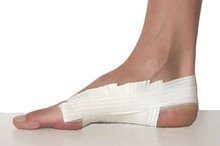What does fact checked mean?
At Healthfully, we strive to deliver objective content that is accurate and up-to-date. Our team periodically reviews articles in order to ensure content quality. The sources cited below consist of evidence from peer-reviewed journals, prominent medical organizations, academic associations, and government data.
The information contained on this site is for informational purposes only, and should not be used as a substitute for the advice of a professional health care provider. Please check with the appropriate physician regarding health questions and concerns. Although we strive to deliver accurate and up-to-date information, no guarantee to that effect is made.
Vitamin D Deficiency & Plantar Fasciitis
The most common cause of heel pain among adults is plantar fasciitis, a condition that affects the fascia, or the thick tissue between your heel bone and your toes. Constant wear of the fascia is generally the cause of plantar fasciitis, and active men ages 40 to 70 are the most vulnerable. Although vitamin D deficiencies can cause a number of bone problems, plantar fasciitis is not one of them.
If you are experiencing serious medical symptoms, seek emergency treatment immediately.
Theories
Vitamin D aids absorption of calcium and ultimately affects bone mass. A lack of calcium or vitamin D leads to bone diseases and conditions, including heel spurs. Because plantar fasciitis was once considered the result of heel spurs, it stood to reason that consuming more vitamin D and calcium could prevent formation of heel spurs and subsequently, plantar fasciitis. Today, researchers know that heel spurs are not the cause of plantar fasciitis, although they sometimes occur with the condition. In fact, X-rays show that not everyone who has plantar fasciitis has heel spurs, according to MedlinePlus 2.
- Vitamin D aids absorption of calcium and ultimately affects bone mass.
- Today, researchers know that heel spurs are not the cause of plantar fasciitis, although they sometimes occur with the condition.
Risk Factors for Plantar Fasciitis
Why You Have Heel Pain After Playing Basketball
Learn More
Although vitamin D deficiencies are not associated with plantar fasciitis, other factors can put you at risk for developing the painful condition. People with flat feet and high arches are more likely to have the condition, as are obese people and those who put stress on their feet through physical activities such as running. Shoes that lack support or have soft soles can also cause undue stress on your feet, increasing your risk of developing plantar fasciitis.
Treatments
Although vitamin D supplements are helpful in preventing bone deterioration and subsequent problems, they are not an approved treatment for plantar fasciitis. Focus instead on resting your affected foot, stretching the heel and wearing shoes with adequate support. Over-the-counter medications, such as ibuprofen and acetaminophen, might also help reduce inflammation and pain, although you should discuss these treatments with your doctor first. Some people find orthotics effective, while others require splints to stretch the tissues and promote healing.
- Although vitamin D supplements are helpful in preventing bone deterioration and subsequent problems, they are not an approved treatment for plantar fasciitis.
- Some people find orthotics effective, while others require splints to stretch the tissues and promote healing.
Considerations
The Best Shoes for Obese People
Learn More
Noninvasive methods are usually enough to relieve plantar fasciitis pain; however, treatments can be lengthy and surgery is sometimes the best option. Talk to your doctor about the right methods for you. Additionally, if you suspect you are deficient in vitamin D, ask about using supplements or sunlight exposure to protect against heel spurs and other health complications.
- Noninvasive methods are usually enough to relieve plantar fasciitis pain; however, treatments can be lengthy and surgery is sometimes the best option.
- Additionally, if you suspect you are deficient in vitamin D, ask about using supplements or sunlight exposure to protect against heel spurs and other health complications.
Related Articles
References
- American Family Physician: Diagnosing Heel Pain in Adults
- MedlinePlus: Plantar Fascitis
- American Academy of Orthopaedic Surgeons. OrthoInfo. Plantar Fasciitis and Bone Spurs. Updated June 201.
- UptoDate. PLANTAR FASCIITIS RISK FACTORS. Updated September 13, 2018.
- Cardenuto ferreira R. Talalgia: plantar fasciitis. Rev Bras Ortop. 2014;49(3):213-7. doi:10.1016/j.rboe.2014.03.012
- Ang TW. The effectiveness of corticosteroid injection in the treatment of plantar fasciitis. Singapore Med J. 2015;56(8):423-32. doi:10.11622/smedj.2015118
- Article titled "Joint Mobilization and Stretching Exercise vs Steroid Injection in the Treatment ofPlantar Fasciitis: A Randomized Controlled Study" by D Celik and co-authors published in Foot & Ankle International in 2015.
- Article titled "Treatment Outcomes of Corticosteroid Injection and Extracorporeal Shock Wave Therapy as Two Primary Therapeutic Methods for Acute Plantar Fasciitis: A Prospective Randomized Clinical Trial" by M Mardani-Kivi and co-authors published in The Journal of Foot & Angle Surgery in 2015.
- LeBlond RF, Brown DD, Suneja M, Szot JF. The Spine, Pelvis, and Extremities. In: LeBlond RF, Brown DD, Suneja M, Szot JF. eds. DeGowin’s Diagnostic Examination, 10e. New York, NY: McGraw-Hill; 2015.
Writer Bio
A health-care professional for more than 10 years, Rica Lewis has obtained numerous certifications in the industry. In 2006 she began channeling her knowledge into health-related articles for print and online publications. Her work has appeared in "Metroparent Magazine," "Anew Heart Healthcare Magazine" and community newspapers. Lewis earned a diploma from LongRidge Writers Institute.







